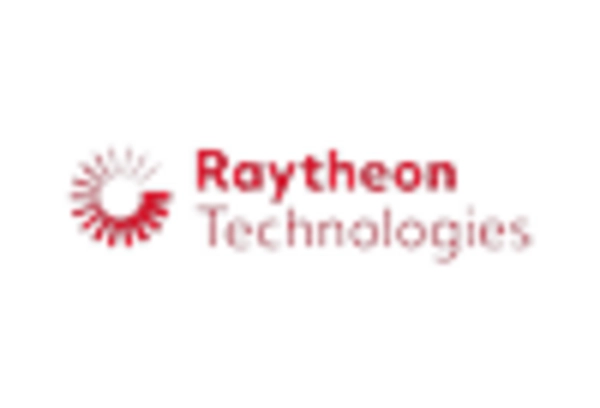Increased Defense Budgets
The Military Sensor Market is experiencing a notable surge due to increased defense budgets across various nations. Governments are prioritizing national security, leading to substantial investments in advanced military technologies. For instance, the United States has allocated over 700 billion dollars for defense in 2025, with a significant portion directed towards enhancing sensor capabilities. This trend is mirrored in countries like India and Russia, where military modernization programs are underway. The focus on upgrading existing systems and developing new sensor technologies is likely to drive market growth, as nations seek to maintain strategic advantages. As a result, the Military Sensor Market is poised for expansion, with projections indicating a compound annual growth rate of around 5% over the next five years.
Increased Focus on Cybersecurity
The Military Sensor Market is increasingly shaped by the heightened focus on cybersecurity. As military operations become more reliant on interconnected sensor networks, the potential vulnerabilities associated with cyber threats have come to the forefront. Defense organizations are prioritizing the development of secure sensor systems that can withstand cyberattacks and ensure data integrity. This shift is prompting investments in advanced encryption technologies and secure communication protocols. The market is witnessing a growing demand for sensors that not only provide situational awareness but also incorporate robust cybersecurity measures. As nations recognize the importance of safeguarding their military assets, the Military Sensor Market is expected to see a rise in demand for secure sensor solutions, potentially leading to innovations in cybersecurity within the defense sector.
Growing Demand for Unmanned Systems
The Military Sensor Market is experiencing growth driven by the increasing demand for unmanned systems, including drones and autonomous vehicles. These platforms rely heavily on advanced sensor technologies for navigation, surveillance, and target acquisition. The proliferation of unmanned aerial vehicles (UAVs) in military operations underscores the necessity for sophisticated sensors that can operate in diverse environments. Reports indicate that the UAV market alone is projected to reach 30 billion dollars by 2026, with a substantial portion allocated to sensor integration. This trend reflects a broader shift towards automation in military operations, where sensors play a crucial role in enhancing operational efficiency and reducing risks to personnel. Consequently, the Military Sensor Market is likely to benefit from this growing reliance on unmanned systems.
Emerging Threats and Geopolitical Tensions
The Military Sensor Market is significantly influenced by emerging threats and geopolitical tensions. As nations face new security challenges, the demand for advanced surveillance and reconnaissance systems is escalating. The rise of asymmetric warfare and cyber threats necessitates the deployment of sophisticated sensors capable of real-time data collection and analysis. For example, the ongoing tensions in Eastern Europe and the South China Sea have prompted countries to enhance their military capabilities, including sensor technologies. This environment fosters innovation within the Military Sensor Market, as defense contractors strive to develop cutting-edge solutions to address these evolving threats. Consequently, the market is expected to witness robust growth, driven by the urgent need for enhanced situational awareness and intelligence gathering.
Technological Advancements in Sensor Systems
Technological advancements are a pivotal driver of the Military Sensor Market. Innovations in sensor technologies, such as artificial intelligence, machine learning, and advanced materials, are transforming the capabilities of military sensors. These advancements enable the development of more accurate, reliable, and efficient systems. For instance, the integration of AI in sensor data processing allows for faster decision-making and improved operational effectiveness. The market is witnessing a shift towards multi-functional sensors that can perform various tasks, thereby enhancing mission success rates. As a result, defense organizations are increasingly investing in these advanced sensor systems, further propelling the growth of the Military Sensor Market. Analysts predict that the market will continue to evolve, with a focus on enhancing sensor interoperability and data fusion capabilities.


















Leave a Comment